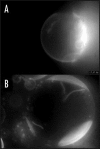Tubular structures in heterogeneous membranes induced by the cell penetrating peptide penetratin
- PMID: 19641736
- PMCID: PMC2717526
- DOI: 10.4161/cib.2.3.8073
Tubular structures in heterogeneous membranes induced by the cell penetrating peptide penetratin
Abstract
The delivery of active molecules into cells requires the efficient translocation of the plasma membrane barrier. Penetratin is a promising cell penetrating peptide is which crosses the cell membrane by a receptor and metabolic energy-independent mechanism. In previous work, we have shown that basic peptides induce membrane invaginations (i.e., tubes formation by induction of negative curvature of membranes) suggesting a new mechanism for cellular uptake of cell penetrating peptides: "physical endocytosis". These effects on membrane curvature are favored in pure liquid disordered but not in pure liquid ordered (raft-like) membrane domains. Herein, we present experiments in heterogeneous membranes composed of mixed domains. The results show that Penetratin is able to induce invaginations in membranes in which liquid ordered and liquid disordered membranes coexist. We suggest that Penetratin is able to recruit specific lipids locally forming fluid membrane patches dispersed inside a liquid ordered membrane zone resulting in the invagination of tubes composed of heterogeneous membrane domains.
Keywords: membrane domains; membrane invagination; penetratin; physical endocytosis.
Figures

Comment on
-
The homeodomain derived peptide Penetratin induces curvature of fluid membrane domains.PLoS One. 2008 Apr 9;3(4):e1938. doi: 10.1371/journal.pone.0001938. PLoS One. 2008. PMID: 18398464 Free PMC article.
Similar articles
-
The homeodomain derived peptide Penetratin induces curvature of fluid membrane domains.PLoS One. 2008 Apr 9;3(4):e1938. doi: 10.1371/journal.pone.0001938. PLoS One. 2008. PMID: 18398464 Free PMC article.
-
Metabolic energy-independent mechanism of internalization for the cell penetrating peptide penetratin.Int J Biochem Cell Biol. 2012 Jun;44(6):869-75. doi: 10.1016/j.biocel.2012.02.010. Epub 2012 Feb 23. Int J Biochem Cell Biol. 2012. PMID: 22387312
-
Lipid domain separation, bilayer thickening and pearling induced by the cell penetrating peptide penetratin.Biochim Biophys Acta. 2010 Dec;1798(12):2223-30. doi: 10.1016/j.bbamem.2009.12.024. Epub 2010 Jan 4. Biochim Biophys Acta. 2010. PMID: 20044976
-
Cell biology meets biophysics to unveil the different mechanisms of penetratin internalization in cells.Biochim Biophys Acta. 2010 Dec;1798(12):2231-9. doi: 10.1016/j.bbamem.2010.02.009. Epub 2010 Feb 10. Biochim Biophys Acta. 2010. PMID: 20152795 Review.
-
Molecular partners for interaction and cell internalization of cell-penetrating peptides: how identical are they?Nanomedicine (Lond). 2012 Jan;7(1):133-43. doi: 10.2217/nnm.11.165. Nanomedicine (Lond). 2012. PMID: 22191782 Review.
Cited by
-
Cholesterol re-organisation and lipid de-packing by arginine-rich cell penetrating peptides: Role in membrane translocation.PLoS One. 2019 Jan 23;14(1):e0210985. doi: 10.1371/journal.pone.0210985. eCollection 2019. PLoS One. 2019. PMID: 30673771 Free PMC article.
-
Amphiphilic Gold Nanoparticles: A Biomimetic Tool to Gain Mechanistic Insights into Peptide-Lipid Interactions.Membranes (Basel). 2022 Jun 29;12(7):673. doi: 10.3390/membranes12070673. Membranes (Basel). 2022. PMID: 35877876 Free PMC article. Review.
-
Interdigitation of Lipids Induced by Membrane-Active Proteins.J Membr Biol. 2019 Oct;252(4-5):331-342. doi: 10.1007/s00232-019-00072-7. Epub 2019 Jun 11. J Membr Biol. 2019. PMID: 31187156
-
The potent effect of mycolactone on lipid membranes.PLoS Pathog. 2018 Jan 10;14(1):e1006814. doi: 10.1371/journal.ppat.1006814. eCollection 2018 Jan. PLoS Pathog. 2018. PMID: 29320578 Free PMC article.
-
Antitumor and modeling studies of a penetratin-peptide that targets E2F-1 in small cell lung cancer.Cancer Biol Ther. 2013 Aug;14(8):742-51. doi: 10.4161/cbt.25184. Epub 2013 Jun 3. Cancer Biol Ther. 2013. PMID: 23792570 Free PMC article.
References
-
- Perez F, Lledo PM, Karagogeos D, Vincent JD, Prochiantz A, Ayala J. Rab3A and Rab3B carboxy-terminal peptides are both potent and specific inhibitors of prolactin release by rat cultured anterior pituitary cells. Mol Endocrinol. 1994;8:1278–1287. - PubMed
-
- Derossi D, Calvet S, Trembleau A, Brunissen A, Chassaing G, Prochiantz A. Cell internalization of the third helix of the Antennapedia homeodomain is receptor-independent. J Biol Chem. 1996;271:18188–18193. - PubMed
-
- Drin G, Cottin S, Blanc E, Rees AR, Temsamani J. Studies on the internalization mechanism of cationic cell-penetrating peptides. J Biol Chem. 2003;278:31192–31201. - PubMed
LinkOut - more resources
Full Text Sources
